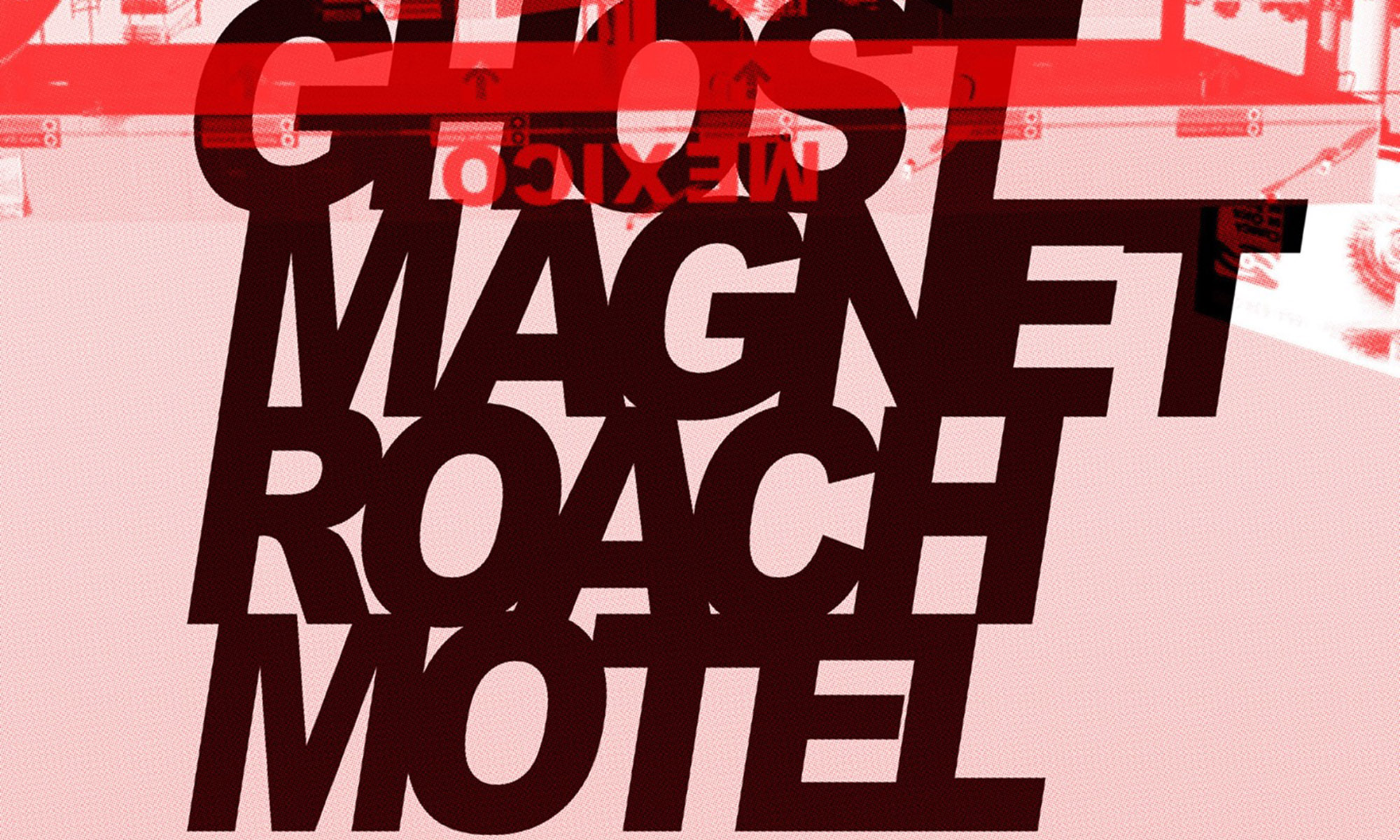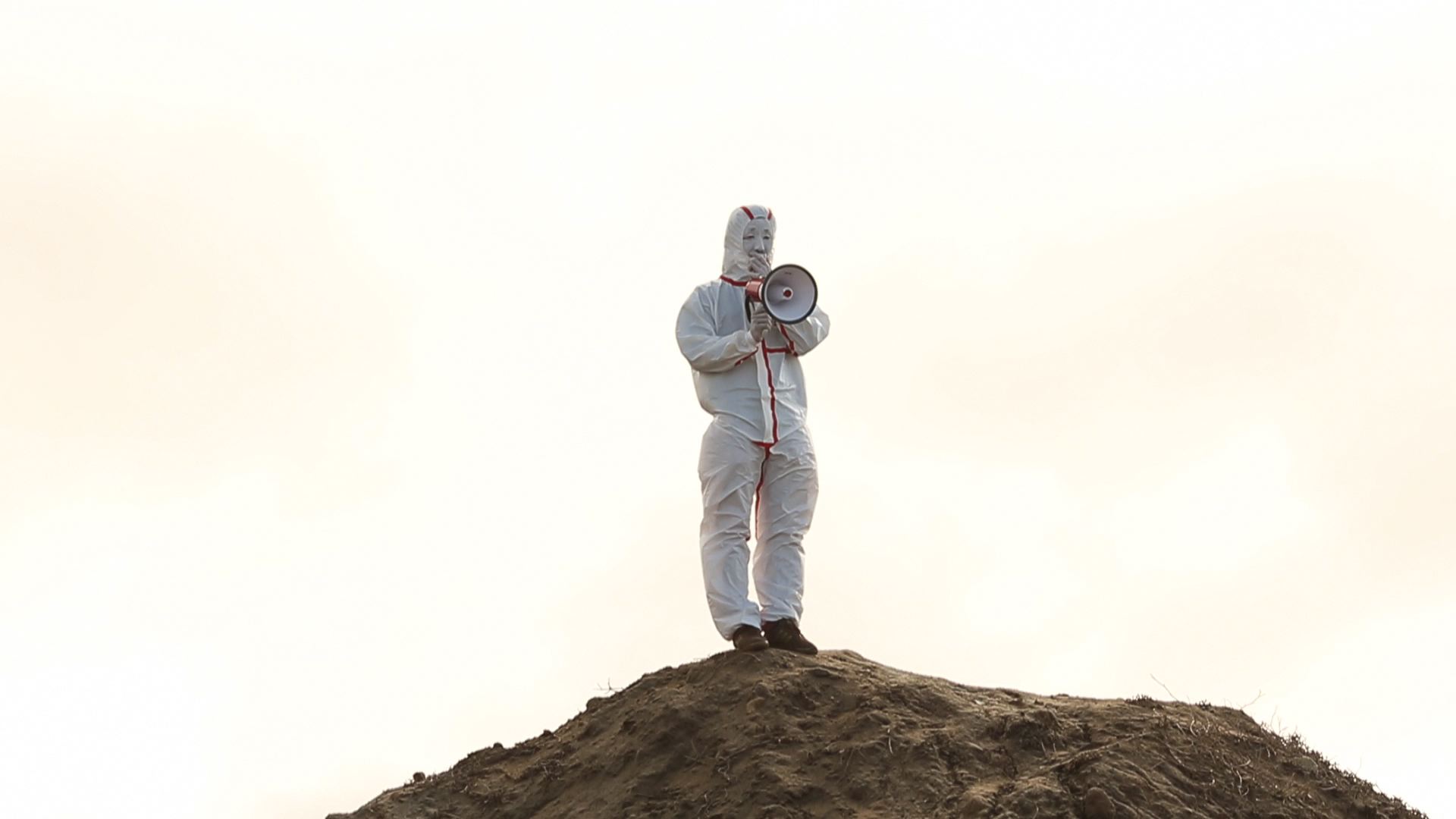Film screening at CECUT, Tijuana Mexico
Ghost Magnet Roach Motel at LAPFF 2017
Ghost Magnet Roach Motel at Los Angeles Asian Pacific Film Festival 207
(https://festival.vconline.org/2017/films/ghost-magnet-roach-motel/)
Visual artist and musician Shinpei Takeda (THE CLOSEST MEXICO TO JAPAN, LAAPFF 2009) returns to Festival Week with a passion project very much in sync with his artistic bent as a global citizen invested in breaking down cultural borders and traditions. GHOST MAGNET ROACH MOTEL is not only the name of the art punk collective musical group he is part of but also, the documentary he has created to chronicle his band’s professional and personal journey as individuals and as a group. Comprised of a Japanese multimedia artist, two American musicians, and two Mexican visual artists and based in San Diego and Tijuana, Mexico, the group’s existence and work present us with an intercultural view of artistic collaboration complete with both literal and figurative “border-crossing.”
Mixing elements of the road movie, experimental cinema, and the tour film, Takeda brings us his own brand of the punk musical documentary, which he has coined as “punkformance” (the mixture of punk music and performance art). Employing use of aggressive sound design and gritty shot selection and fusing together his worlds of punk rock music and visual artistry, he serves up both a one-two punch of both the joys and challenges of DIY musicianship and the personal demons of those creative personalities often involved. Drummer Brian Sueda’s on-and-off drug addiction, for instance, gets his bandmates to enact an intervention and escort him down to a rehab center south of the border in order to seek treatment. The band as an ad-hoc family unit saves Sueda’s life as one bandmate intuitively chimes in, “You didn’t hate your life when you play with Ghost Magnet […]”
In the humble, grand tradition of guerilla-style filmmaking and aesthetics, Takeda melds and mixes various visual styles in his vérité camerawork, media formats, and B/W and color shooting flexing to whatever mood he wants to convey at any given moment. In doing so, he hopes to immerse his audience, both filmic and music, into a fully sensational, auditory and visual experience that should not be missed.
— Melanie Ramos, with additional contributions by Lindy Leong
Community Partners: Giant Robot, Save Music in Chinatown
Director’s Bio
Shinpei Takeda is a Japanese artist and filmmaker based in Tijuana, Mexico and Düsseldorf, Germany. His works involve a wide range of themes regarding memories and history. His recent projects include Alpha Decay, Beta Decay, and Antimonument. He is also the director of Ghost Magnet Roach Motel, the punkformance unit from Tijuana and the main topic of the movie.
Credits
Producers: Shinpei Takeda, Adriana Trujillo
Director: Shinpei Takeda
Photography: Joey Muñoz, Johann Leitner
Art Director: Daniel Ruanova
Sound Mix: Jose Inerzia
Music: Tony Cozano, Brian Sweda, Julio Orozco
Editors: Shinpei Takeda, Margit Bauer
Q&A with Director Shinpei Takeda
Q and A with Director Shinpei Takeda
By Martin Wong of Save Music in Chinatown
In my past life, I’ve supported attended film festivals as a writer, judge, and participant. And now I just go for fun. I love independent, underground, and international movies–not to mention pretty much every trashy genre flick and a handful of arty ones–and how cool is it to watch them with a crowd of like-minded fans? I hate watching on a laptop and actually borrow DVDs from the library to watch on TV if I have to.
So I was stoked and flattered when friends at the Los Angeles Asian American Pacific Film Festival reached out to me and asked if Save Music in Chinatown would be a community sponsor for Ghost Magnet Roach Motel, an art-damaged documentary by a Japanese guy about a noise band from San Diego and Tijuana. First, we achieved “community” status? Second, sign us up!
I took advantage of the situation to hassle director Shinpeil Takeda about his movie, his band, his art, and his life for posting purposes. What an interesting human being, and I look forward to meeting him and perhaps seeing some of you at the screening at the CGV Cinemas in Koreatown on May 3 at 9:30 pm.
Explain your international background. Where did you grow up and how did you become a visual artist?
I was born in Osaka, Japan. Because of my salaryman father, who moved to different places for his company, we lived in Düsseldorf, Germany for 5 years (where I’ve spent half of my time for the last 3-4 years) and Chicago for few years. Then I went back to Japan for most of my adolescence but went to North Carolina to study geology.
After that, I went to San Diego to start a nonprofit and earn a master’s degree in organizational theories. I founded and ran the AJA Project, which I am still involved in, but I got tired of it and also my relationships in the United States or maybe SoCal or maybe just my immediate surroundings, and moved to TJ.
When I crossed the border, I discovered something else about human relationships—different notions of family, individuality, and collectivity, and so on–that are augmented by the damn geopolitical psycho cultural border… That is one of the big themes in the movie.
That was almost 12 years ago in 2005. When I crossed the border, I started producing my first documentaries, images, and installations. I became artist and TJ was like my art school.
What exactly is your relationship and role with the band?
I am kind of the founder and producer, as well as a participating artist. The band started almost 12 years ago in San Diego and, when I started living in Tijuana, we got joined by some of the best visual artists of TJ (Daniel Ruanova, and Julio Orozco) along with the surviving members of the American side of the band (Brian Sweda and Tony Cozano).
When you started making the movie, was it to share the music or tell the band’s story?
This is my third feature-length movie. The first was called El Mexico mas cercano a Japan, about a Japanese photographer Kingo Nonaka who was the first documentary photographer of Tijuana in 1920s. The second was Hiroshima Nagasaki Download, a road movie in which young Japanese friends visit and interview the atomic bomb survivors of Hiroshima and Nagasaki living on the West Coast as they drive from Vancouver to Tijuana.
I wanted to make another movie with a different type of storytelling and very little or almost no critical distance since I would be very much a participant in it. I would have a very biased outlook but hoped that the intimacy of the work would make audiences get to the core of our human experiences and struggles existing in this world with borders in every dimension.
I think a traditional movie about a band is usually about its success, way to fame, and ups and downs—not about its music as sound. I wanted the movie to be another output of this project and an extension of what we do with our noise punkformance. In a way, all the protagonists of the film are punk-forming, living their lives and struggling but keeping up the punk spirit against the system and humanity’s decay.
What is “punkformance”?
Punk+performance
Who is your audience and how do you feel watching your friends onscreen?
I am still trying to understand who my audience is. Of course, my friends onscreen are important. I want them to see themselves on the big screen and see that their story is valid and important and how it can affect people. In a way, they represent different parts of myself and different possibilities. But I also respect each one of them as artists, and I think the film editing shows that however fucked up they are, there is always dignity.
The San Diego Latino Film Festival showed it, but the San Diego Asian film Festival didn’t take it. And now with the LAAPFF, I myself am trying to figure whose story it is. We will see.
How have your bandmates received it? Were they involved in the edits?
I had to run away from Tijuana to edit because it was too intense and I couldn’t see it from far away. So I got a grant in Düsseldorf, Germany, where I used to live as a kid, and worked on the film with a German editor. I wanted it to decontextualize it so that notions of addiction or borders could be much more universal rather than just alcohol or the specific border of TJ-SD.
I kept updating them with the edits, but most of them trusted me. It was natural and that is how we play music, too. We just trust each other and immediately make a wall of noise. They are cool artists, so I know they get it.
But even though I wanted to get them to come to the movies, when we showed the film in San Diego one member came drunk 10 minutes after the movie ended. In the movie, he goes to rehab but, as you can imagine, life is much more complex. Art cannot heal people.
Art is fragile and requires a lot of sensitivity, precisely because we are all artists and it isn’t easy for us to have our complete individual freedom yet produce something collectively. But that is what I think we achieve in the movie and in this project. That type of human relationships is very difficult to build in society.
Can we get back to the AJA Project and your work with refugee kids? What exactly is “participatory photography” and how do you use it to help them?
The AJA Project has been working with refugee kids (Afghani, Iraqi, Somali, Burmese, Syrians), as well as other marginalized kids (immigrant, homeless, teenage mothers, juvenile court system…) in San Diego. We teach not just technical aspects of photography but how to use it as a tool to tell stories and to communicate. Find your voice, use your voice, and raise your voice—that is the thing!
We do a big public exhibition of their work to create a full circle in which they can see that their photographs and stories are not only valid, but also important. They are in fact good documentarians because they see American society from the outside, just like how I saw the U.S. coming from other countries.
It is bit related to my band and Ghost Magnet Roach Motel in the essence of providing an outlet for your chaos.
That’s great, connecting the arts and the underground and empowering children with them.
For me, they are part of the same thing.
Ghost Magnet Roach Motel – The Movie – Coming Soon
Coming soon in 2014

